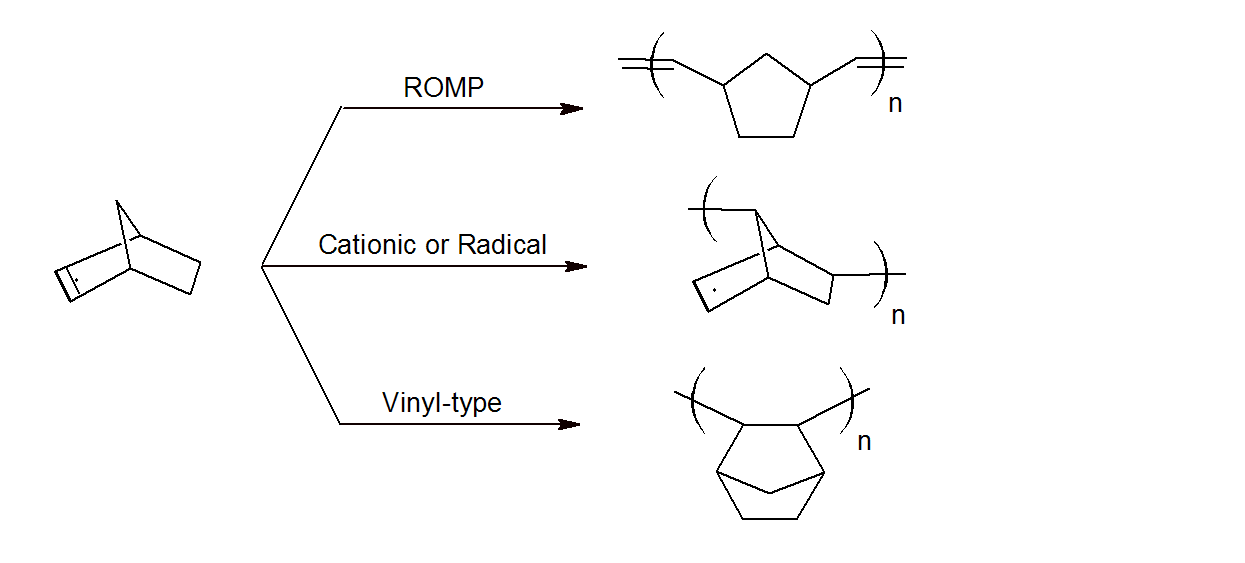Cyclic Polyolefins and
Copolymers
(Norbornene, Cyclopentadiene, Dicyclopentadiene)
Properties
Cyclic olefin polymers are attractive high temperature polymers with outstanding optical properties, good chemical and heat resistance, and excellent dimensional stability. The three most important cyclo olefin monomers are norbornene, cyclopentadiene (CPD), and dicyclopentadiene (DCPD). The later two make up the largest portion in the C5 stream from steam cracked naphtha and account for about 15 to 25% of the total C5 fraction. Norbornene is only a minor component of the C5 stream and is usually produced by the Diels-Alder reaction of cyclopentadiene and ethylene. A commercially important derivative of norbornene is 5-ethylidene-2-norbornene (ENB) which is also made by Diels-Alder reaction with butadiene as the coreactant.

Synthesis
Cyclo alkydiene monomers can undergo a number of different types of polymerizations (see reaction scheme below). One of the most widely used methods is ring-opening metathesis polymerization (ROMP). Using well-defined catalysts, ROMP allows for the control of the stereochemistry and molecular weight. Cationic and free radical polymerization is also possible which leads to saturated low molecular weight oligomers.1 These methods are less well known and have little to no commercial use. A third method is vinyl addition polymerization. In this case only the π-bond of the cyclolefin reacts whereas the bicycle structure remains intact. This type of polymerization yields high molecular weight polymers with good heat resistance, mechanical strength and high transparency.
Pathways of Norbornene Polymerization

Cyclopentadiene (DCPD) is an important thermoset resin that can be reaction transfer molded (RTM) or reaction injection molded (RIM) into large parts that have excellent dimensional stability. Larger parts are usually reinforced with glass fibers, mica or fiber meshes. The later is placed in the mold and the polymer resin is injection molded over it. DCPD is often an environmental friendly alternative to traditional epoxy resins. Molded DCPD parts, when compared to traditional unsaturated polyester and vinyl ester parts, have much improved toughness and stiffness, and better corrosion resistance. Since the resin is of lower viscosity, less styrene is needed and single stage cure is possible.
Norbornene when polymerized by ROMP is a high molecular weight polymer that contains double bonds and thus, can be vulcanized with common accelerator systems for rubber vulcanization. However, pure polynorbornene is not an elastomer; to obtain elastomeric properties, the glass transition temperature of the polymer has to be lowered below room temperature. This is usually achieved by blending the polymer with common aromatic and paraffinic oils that act as plasticizers. The plasticized polynorbornene rubber (PNR) has good heat, ozone, and weathering resistance and excellent noise and vibration damping properties but only fair compression set, low abrasion resistance, and poor resistance to swelling in most hydrocarbon oils.
Small amounts of ethylidenenorbornene or dicyclopentadiene are sometimes copolymerized with ethylene and/or propylene to improve their performance properties and to provide double bonds for cross-linking (vulcanization) of the ethylene-propylene-diene-monomer rubber (EPDM). These elastomers have excellent heat, weathering and aging resistance. They also exhibit excellent electrical insulation, compression set, and low temperature properties, but only fair physical strength properties.
Vinyl-type addition polymerization of norbornene yields high temperature polymers with high crystallinity and high glass transition temperature (≈ 650 K), good heat resistance, and excellent dimensional stability. However, these polymers are rather brittle. To lower the crystallinity, norbornene is usually copolymerized with ethylene and propylene using metallocene catalyst which yields fully amorphous, transparent cyclic oelfin copolymers (COC) that are easy to process. These copolymers exhibit a unique combination of properties including high light transmissivity, low birefringence, high refractive index, extremely low water absorption, excellent biocompatibility, good chemical resistance, very low water vapour permeability as well as high rigidity, strength and hardness. These properties can be modified over a wide range by varying the proportions of norbornene and ethylene in the backbone and the overall structure of the copolymer.
Commercial Cyclic Polyolefin Products
Major manufacturers of cyclic oelfin copolymers (COC) are Topas, JSR, Mitsui, and Zeon. It is marketed under a variety of commercial names, including Apel, Arton, Topas COC, and Zeonex. A major manufacturer of polynorbornene rubber is Der-Gom.
Applications
Dicyclopentadiene (DCPD) is widely used in unsaturated polyester resins. It is often blended with other resins to improve their dimensional stability (higher HDT, lower shrinkage) and processability (higher filler loading). The addition of DCPD also improves the surface quality of sheet and bulk molded parts consisting of fiberglass, fillers, and unsaturated polyester. Large parts of DCPD composites find uses in the transportation and energy industry as wind turbine blades and car body parts.
Polynorbornene (PNB) elastomers are used for the production of a wide variety of rubber articles with very good noise and vibration damping properties and friction control. PNR elastomers find applications in the automobile, electronic, construction and sports-recreation equipment industry. PNB is also known as a super absorbent polymer. It can absorb up to 30 times of its own weight of oil and is one of the most absorbing oil binding systems for hydrocarbon oils.
Cyclic oelfin copolymers (COC) find growing use as a shatter-resistant substitute for glass in optical lenses and films particularly in medical and electronic applications such as diagnostic tubes, touch screens (ITO film), light guides, and reflection films. Their excellent biocompatibility, chemical resistance and superior water vapor barrier also makes them a good choice for primary packaging of pharmaceuticals and for medical diagnostic disposables.
1C. Janiak, P.G. Lassahn, Macromol. Rapid Commun., 22, No. 7 (2001)
* DCPD Monomer